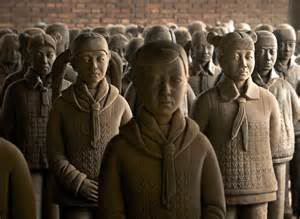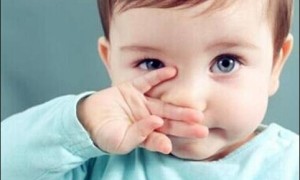
When Emperor Qin Shi Huang, the first emperor of China, anticipated his death more than 2,000 years ago, he wanted an army of warriors to guard his mausoleum forever and protect him in the afterlife.
So he ordered the creation of some 8,000 terra-cotta soldiers, along with hundreds of terra-cotta horses and chariots, to be buried with him in his tomb. Historians speculate the soldiers were modeled after eight individuals. When the statues were discovered by workers digging a well in Xi'an, Shaanxi Province, in 1974, the world was stunned by the spectacular funerary art and the legacy of the powerful emperor. Since then, it's become a major tourist attraction and a World Heritage site.
Now, these soldiers have a counterpart: female terra-cotta warriors.
Prune Nourry, a Paris-born artist based in New York City, has created a small army of them. In "Terracotta Daughters," 116 are featured in an exhibition at the China Institute from September 10 through October 4. The show's US premiere is presented by theFrench Institute Alliance Francaise and China Institute as part of FIAF's Crossing the Line festival.
The difference is these female terra-cotta warriors are not out to protect any emperor, but were created to bring attention to the plight of girls in China.
"In China, there is a huge imbalance between boys and girls. I wanted to highlight the issue of gender preference," said Nourry. "I needed a strong cultural symbol to base this project on, and a universal one that would speak both to Chinese villagers in the countryside and to citizens abroad."
And, in a striking parallel to the terra-cotta soldiers, the terra-cotta girls will also become an archaeological project. After the exhibition, they will be buried in China until 2030, the year that, according to Chinese sociologists, men will have the hardest time finding a wife because of the skewed gender ratio.
The imbalance of the sexes is a serious problem for the Chinese. A 2010 census indicates there are at least 34 million more men than women. Due to the one-child policy and traditional preference for boys, as well as sex-selective technologies, China will have a huge surplus of men, which presents daunting demographic challenges for the world's most populous country.
Perhaps for those reasons, Nourry didn't encounter difficulties with the Chinese government in pursuing this project in China. She started working on the terra-cotta statues two years ago after finishing an installation in India that also explored gender bias.
In deciding on the size of the female army, Nourry chose the number eight because of its auspiciousness in Chinese culture. She created the first eight statues modeled after eight girls whom she met through an orphan charity in China.
Then, working with local craftsmen in Xi'an, 108 permutations of statues were made based Nourry's original eight statues by combining the different heads, torsos and legs. "For Xian Feng, the main craftsman I worked with in China, my project seemed at first impossible since women 'can't be soldiers.' But after we began the project, he changed his view and even turned one of the 108 combinations into a portrait of his own daughter," said Nourry.
The local craftsmen of Xi'an are used to making copies of the terra-cotta warriors which are sold primarily to tourists. When Nourry asked them to give their artistic interpretation in sculpting the female statues, they were initially tentative. Over time, they lost their hesitancy and gave each statue unique faces. No two statues have the same features.
Each terra-cotta warrior girl stands nearly 5 feet tall and weighs about 260 pounds. Their hairstyles are contemporary, as are their uniform, which is modeled after the orphan girls' school attire. Unlike the male warriors, they look approachable, friendly and even charming.
"It was a very enriching collaboration, based on exchange and mutual respect," said Nourry.
Her favorite moment was when the eight girls saw the terra-cotta statues of themselves and were delighted. Part of the proceeds from the sale of the eight original statues will pay for the cost of the eight girls' education for three years.
"Terracotta Daughters" is impressive in its artistic craftsmanship and social statement. It's a refreshing reinterpretation of one of China's national symbols. With these modern female warriors, Prune raises the pressing issue of gender discrimination without pointing fingers at anyone or anything. One looks at these amazing terra-cotta statues and feel compelled to ask -- why aren't there more of them? And why aren't there more girls in China?查看译文
2000多年前,当中国第一位皇帝秦始皇预见到自己驾崩时,他想要一支兵马俑能在阴间永久守护他及他的陵墓。
所以,他下令建造约8000名兵佣,以及数以百计的马佣和战车作为陪葬。历史学家推测这些士兵是模仿八个不同的人建造的。1974年,陕西西安的农民在打井时发现了这些雕像,这种壮观的丧葬艺术及强大王朝的传奇让世界为之震惊。从此以后,那里就成为主要的旅游景点和世界文化遗产。
现在,这些士兵在性别上有了对应:女兵马俑。
出生于巴黎的纽约艺术家蒲玉娜·诺赫伊(Prune Nourry)创建了这支女兵马俑。由116件塑像组成的“女童俑”(TerracottaDaughters)将于9月10日至10月4日在中国研究所展出。这次展览的美国首映是由法国文化协会(French Institute Alliance Francaise)和中国研究所(China Institute)共同承办,这也作为法国文化协会越界节活动的一部分。
不同的是这些女兵马俑不是用来保护皇帝的,而是用来引起对中国男女不平衡状态的关注。
“在中国,男女之间存在着极大的不平衡。我想强调的是性别偏好问题,”诺赫伊称。“我需要一个强有力的文化标志融入到这个项目,以及中国农民和海外公民都看得懂的标志。”
并且和兵马俑类似,这些女童俑也将成为一个考古项目。展览结束后,它们会被埋在中国直到2030年。据中国社会学家称,因为中国性别比例失调,那一年将是男性最难找到配偶的时期。
性别比例失衡对于中国人来说是个严峻的问题。2010年的人口普查表明,男性至少比女性多3400万人。由于独生子女政策,传统的重男轻女观念以及性别选择技术,中国将出现男性过剩,这也为这个世界人口大国带来严峻挑战。
也许因为这些原因,诺赫伊在中国推行这个项目并没有遭到中国政府的为难。两年前,在结束印度同样探究性别歧视的装置作品展后,她开始建造兵马俑。
在决定女子军队规模上,诺赫伊选择了数字8,因为在中国文化中8是吉利数字。通过中国的一所孤儿院,她选择那里8个女孩为原型创建了头8个雕像。
然后,根据诺赫伊原始的8个雕像,通过结合不同的头像、躯干和腿,她与西安当地工匠又建造了108个雕像。诺赫伊称“在中国和我一起共事的主要工艺师为宪峰(音译),起初我的项目不太可能完成因为女性‘不可能成为士兵’。但在我们开始这个项目后,他改变了看法,甚至把其中一个雕塑头像变成了她女儿的。”
西安当地工艺师过去常制作兵马俑仿品卖给游客。当诺赫伊要求他们在塑造女性雕像融入他们的艺术诠释时,他们最初还比较犹豫。随着时间的推移,他们不再犹豫,给每个雕像塑造了独一无二的头像。没有任何一个雕像重样。
每个女童兵马俑近5英尺高,约260磅重。她们的发型是现代的,他们的穿着也同样现代化,这是仿照孤儿院女孩的学校服装。不同于男兵马俑,她们看起来更平易近人,友好,并且充满魅力。
诺赫伊称“这是一次基于交流和相互尊重的十分充实的合作。”
令她最开心的时刻是,当8个女孩看见自己的兵马俑雕像时的欣喜。8个原始雕像所卖收入的一部分将用于支付这8个女孩三年学费。 “女童俑”的艺术工艺和社会表现令人印象深刻。这让中国国家标志焕然一新,给予了新的诠释。诺赫伊没有指责任何人或任何事,通过这些现代女兵马俑揭露了性别歧视问题。有人看了这些令人惊叹的兵马俑后,不禁问道——为什么这样的雕像不再多点?为什么中国不能有更多的女孩?







